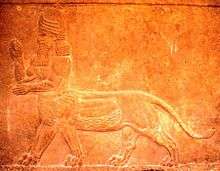Urmahlullu
Fantastical and mythological lion-centaur hybrid creatures, that is, quadrupedal felines from the waist down and humanoids from the waist up, have appeared in the mythology of several cultures of antiquity as well as in European art of the Middle Ages and early Renaissance.
 | |
| Grouping | Mythological hybrids |
|---|---|
Ancient Assyria and Mesopotamian Culture
The urmahlullu ("untamed lion man") is a mythical ancient Mesopotamian beast with a lion-centaur appearance. It was sometimes depicted as holding a club and wearing a cap of divinity. A guardian spirit, its image was used to ward against various malign demons, including the winged death demon Mukīl rēš lemutti[1] and the lavatory demon Šulak.[2] Statues of Urmahlullu were sometimes placed outside lavatories, such as those in Nineveh's North Palace,[3] or buried on either side of the lavatory door in homes wealthy enough to have lavatories on the premises.[2]
Urmahlullu also appear on Assyrian cylinder seals.
Indus Valley and Harappan Culture
Urmahlullu also appear in cylinder and square seals found in excavations of the Indus Valley city-state of Kalibangan. In one scene, a researcher describes a lion-centaur goddess wearing a head-dress with a long pendant whose body merges with that of the tiger. This goddess is associated with the later Hindu goddess of war. (Source: a 2013 book of academic papers -- specifically, the paper, "Regional Diversity in the Harappan World: The Evidence of the Seals" by Marta Ameri. https://www.harappa.com/sites/default/files/pdf/Ameri-%20Regional%20Variation%20in%20the%20Indus%20with%20front%20matter.pdf chapter 19 pages 365-366 figure K-50A.)
Medieval Europe
At this time known as sagittaries, lion-centaurs appear as grotesques in prayer books, gargoyles in churches, and as aquamanilia. Etienne de Blois, later King Stephen of England, featured sagittaries on his coat of arms and was known as "the Sagittary of London Park."
References
- Bane, Theresa. Encyclopedia of beasts and monsters in myth, legend and folklore. Jefferson, North Carolina. p. 328. ISBN 9780786495054. OCLC 930364175.
- A.R. George (2015). ON BABYLONIAN LAVATORIES AND SEWERS. Iraq, 77, pp 75-106 doi:10.1017/irq.2015.9
- Kertai, David. The architecture of Late Assyrian royal palaces (First ed.). Oxford. p. 192. ISBN 9780191789724. OCLC 908099822.